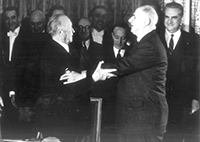
|
||
|
Si vous ne parvenez pas à lire la newsletter, suivez ce lien |
||
|
|
Newsletter |
|
|
Version française | 2015 - N°1 |
22 janvier 1963: signature du traité de l’Élysée |
|

Le 22 janvier 1963, Charles de Gaulle et Konrad Adenauer signent, au palais de l'Élysée, un traité bilatéral solennel renforçant les liens entre la France et la République fédérale d’Allemagne en matière de sécurité et de diplomatie. Le traité organise une étroite coopération entre les deux pays dans le domaine des affaires étrangères, de la défense, de l'éducation et de la jeunesse. Le traité de l'Élysée définit une méthode de coopération intergouvernementale (rencontres régulières à tous les niveaux). Cependant, il ne comporte aucun engagement contraignant en ce qui concerne l'harmonisation des positions internationales. Initialement prévu comme une simple notification écrite des axes sur lesquels les deux pays s'étaient mis d'accord pour relancer leur coopération, le traité prend la forme d'un document cadre très bref (19 articles au total) qu'accompagne une déclaration commune qui fixe la tonalité politique du texte. Le chancelier allemand et le président français, scellant ainsi l'amitié entre la France et l'Allemagne, réaffirment dans la déclaration commune accompagnant le traité, leur conviction que «la réconciliation du peuple allemand et du peuple français, mettant fin à une rivalité séculaire, constitue un évènement historique qui transforme profondément les relations entre les deux peuples». |
Dossier thématique: Le «couple franco-allemand» et l'Europe à travers la caricature (1945-2013) |
|

À l’occasion de l’anniversaire de la signature du traité de l’Élysée, découvrez la publication du CVCE entièrement consacrée au «couple franco-allemand» et son influence sur l’histoire de la construction européenne. «Le ‘couple franco-allemand’ et l'Europe à travers la caricature» présente près de 400 dessins de presse qui éclairent sur un ton décalé et humoristique cette période charnière de l'histoire pendant laquelle l'Europe unie s'est construite et dresse un bilan sur plus de 50 ans de coopération franco-allemande. Le rapprochement entre la France et l'Allemagne, deux pays longtemps ennemis héréditaires, est le résultat d'un processus, qui depuis la fin de la Seconde Guerre mondiale, a connu une évolution hors du commun. Outre les caricatures, la publication comprend de nombreuses autres ressources documentaires et des outils numériques (chronologie interactive, notices biographiques, bibliographie). La publication est disponible en français, en anglais et en allemand. |
|
Autres actualités |
|
|
Contribution au Master en histoire européenne contemporaine à l’Université du Luxembourg Participation au XIIIe congrès de l’Association italienne pour l’histoire de la pensée économique La collaboration entre le CVCE et la famille Werner continue
|
|
|
Se désinscrire de cette liste | Contactez-nous
|
|

|
||
|
Email not displaying correctly? View it in your browser. |
||
|
|
Newsletter |
|
|
English version | 2015 - N°1 |
22 January 1963: signing of the Élysée Treaty |
|

On 22 January 1963, at the Élysée Palace in Paris, Charles de Gaulle and Konrad Adenauer signed a bilateral treaty that strengthened links between France and the Federal Republic of Germany in the field of security and diplomacy. The treaty provided for close cooperation between the two countries in the areas of foreign affairs, defence, education and youth. While the Élysée Treaty defined a method of intergovernmental cooperation (regular meetings at all levels), it did not include any binding commitments with regard to the harmonisation of international stances. The treaty was initially intended to be a simple written notification of the areas in which the two countries had agreed to renew their cooperation — it was a very brief framework document (19 articles in all), annexed to which was a joint statement laying down the political tenor of the text. In this joint statement, the German Chancellor and the French President set the seal on Franco-German friendship by confirming their conviction that ‘the reconciliation of the German people and the French people, ending a centuries-old rivalry, constitutes a historic event which profoundly transforms the relations between the two peoples’. |
|
Subject file: The ‘Franco-German duo’ and Europe as seen in cartoons (1945–2013) |
|

On the anniversary of the signing of the Élysée Treaty, why not take a look at the CVCE’s publication on the ‘Franco-German duo’ and its influence on the history of European integration? The ‘Franco-German duo’ and Europe as seen in cartoons (1945–2013) contains more than 400 press cartoons that offer a humorous, quirky interpretation of this important historical period in which a united Europe began to take shape, and reflects on more than 50 years of Franco-German cooperation. The rapprochement that began in the early years after the Second World War between France and Germany, two countries that had been long-standing enemies, followed a unique path. As well as cartoons, this publication includes several other documents, resources and digital tools (an interactive timeline, short biographies and a bibliography). It is available in French, English and German. |
|
Other news |
|
|
Contribution to the Master’s in Contemporary European History at the University of Luxembourg Participation in the XIII Conference of the Italian Association for the History of Economic Thought Continued cooperation between the CVCE and the Werner family
|
|
|
Unsubscribe from this list | Contact us
|
|